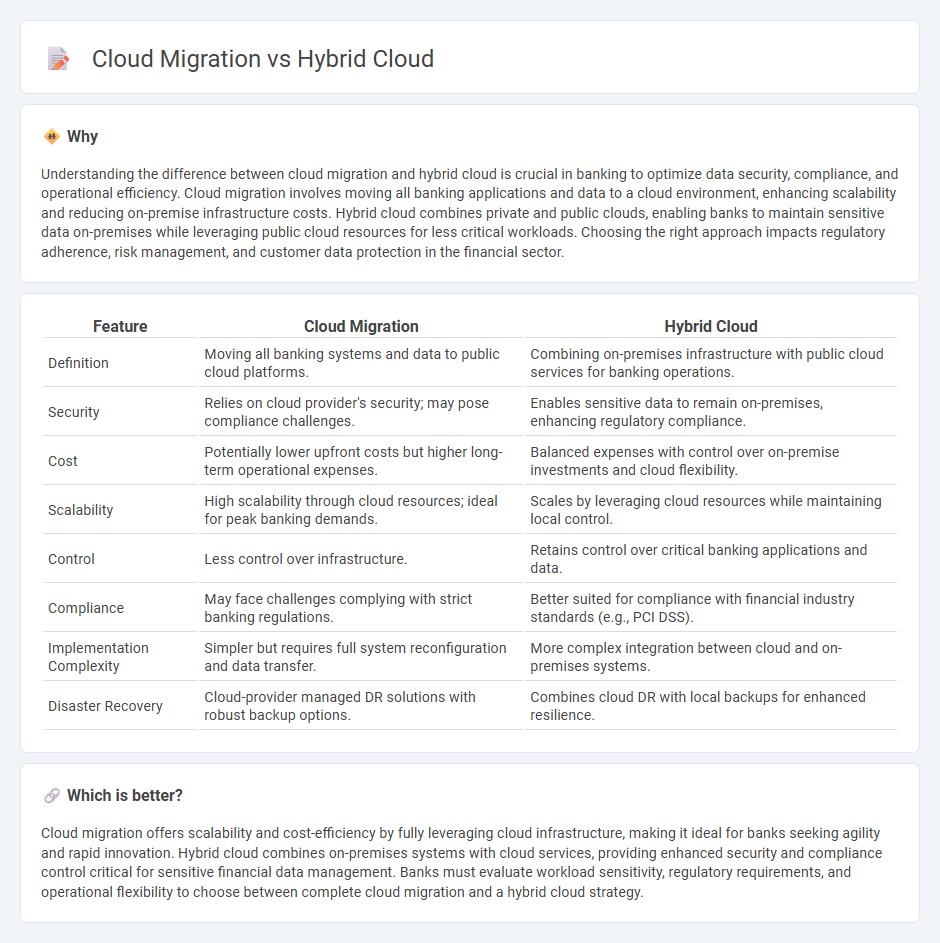
Cloud migration enables banks to transfer data and applications entirely to cloud platforms, enhancing scalability and reducing infrastructure costs. Hybrid cloud combines on-premises systems with cloud services, offering greater flexibility and data security for financial institutions. Explore how these approaches transform banking operations and improve service delivery.
Why it is important
Understanding the difference between cloud migration and hybrid cloud is crucial in banking to optimize data security, compliance, and operational efficiency. Cloud migration involves moving all banking applications and data to a cloud environment, enhancing scalability and reducing on-premise infrastructure costs. Hybrid cloud combines private and public clouds, enabling banks to maintain sensitive data on-premises while leveraging public cloud resources for less critical workloads. Choosing the right approach impacts regulatory adherence, risk management, and customer data protection in the financial sector.
Comparison Table
| Feature | Cloud Migration | Hybrid Cloud |
|---|---|---|
| Definition | Moving all banking systems and data to public cloud platforms. | Combining on-premises infrastructure with public cloud services for banking operations. |
| Security | Relies on cloud provider's security; may pose compliance challenges. | Enables sensitive data to remain on-premises, enhancing regulatory compliance. |
| Cost | Potentially lower upfront costs but higher long-term operational expenses. | Balanced expenses with control over on-premise investments and cloud flexibility. |
| Scalability | High scalability through cloud resources; ideal for peak banking demands. | Scales by leveraging cloud resources while maintaining local control. |
| Control | Less control over infrastructure. | Retains control over critical banking applications and data. |
| Compliance | May face challenges complying with strict banking regulations. | Better suited for compliance with financial industry standards (e.g., PCI DSS). |
| Implementation Complexity | Simpler but requires full system reconfiguration and data transfer. | More complex integration between cloud and on-premises systems. |
| Disaster Recovery | Cloud-provider managed DR solutions with robust backup options. | Combines cloud DR with local backups for enhanced resilience. |
Which is better?
Cloud migration offers scalability and cost-efficiency by fully leveraging cloud infrastructure, making it ideal for banks seeking agility and rapid innovation. Hybrid cloud combines on-premises systems with cloud services, providing enhanced security and compliance control critical for sensitive financial data management. Banks must evaluate workload sensitivity, regulatory requirements, and operational flexibility to choose between complete cloud migration and a hybrid cloud strategy.
Connection
Cloud migration enables banks to transfer critical applications and data from on-premises infrastructure to cloud environments, enhancing scalability and operational efficiency. Hybrid cloud solutions combine private and public clouds, allowing banks to maintain sensitive data on private servers while leveraging public cloud resources for less sensitive workloads. This integration optimizes cost management, data security, and regulatory compliance in banking operations.
Key Terms
Data Security
Hybrid cloud environments combine private and public clouds, offering enhanced data security by enabling sensitive information to remain on-premises while leveraging public cloud scalability. Cloud migration involves transferring data and applications to the cloud, which requires robust encryption, identity management, and continuous monitoring to prevent breaches during and after the transition. Explore best practices and tools to secure your data throughout hybrid cloud adoption and cloud migration processes.
Compliance
Hybrid cloud environments offer enhanced compliance by enabling data residency control and meeting regional regulatory requirements through selective workload placement. Cloud migration demands thorough compliance assessments to address data privacy, security standards, and industry-specific regulations before transferring workloads. Explore in-depth strategies to ensure compliance during cloud migration and optimize hybrid cloud deployments.
Legacy Integration
Hybrid cloud enables seamless legacy integration by combining on-premises infrastructure with public cloud resources, allowing enterprises to maintain existing systems while leveraging cloud scalability. Cloud migration often involves moving legacy applications entirely to the cloud, which can present challenges in compatibility and data synchronization. Explore detailed strategies for legacy system integration and optimization in hybrid environments to maximize IT agility and performance.
 dowidth.com
dowidth.com